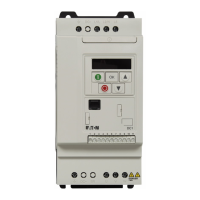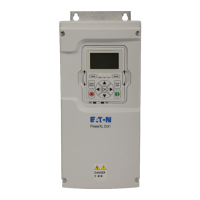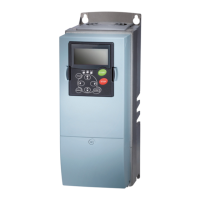6 Parameters
94 DC1 Frequency Inverter 10/12 MN04020003Z-EN www.eaton.com
P-07 135 – rw Nominal voltage of the motor 230
1)
Setting range: 0. 20 - 250 / 500 V (→ Motor ratings plate)
Pay attention to the mains voltage and the type of circuit in the stator
winding!
Note:
This parameter has a direct influence on the V/Hz characteristic curve
(e.g. operation with the 87-Hz characteristic curve). This must be espe-
cially taken into account in the case of values (P-07) that deviate from
the frequency inverter's rated operational data (U
LN
= 100 %). This may
cause the over-excitation of the motor and thus lead to an increased
thermal load.
P-08 136 ✓ rw Rated motor current 4.8
1)
Setting range: 0.2 x I
e
-2x I
e
[A]
I
e
= Frequency inverter’s rated operational current
(→ Motor rating plate)
P-09
137 – rw Nominal frequency of the motor 50.0
1)
Setting range: 25 – 500 Hz (→ Motor ratings plate)
Note:
This parameter value is also automatically applied as the cut-off
frequency
for the V/Hz characteristic curve.
P-10
138 ✓ rw Nominal speed of the motor 0
0 - 30,000 rpm (min
-1
) (→ motor rating plate)
Note:
This parameter can be optionally set to the motor‘s rated speed (revo-
lutions per minute, rating plate). If it is set to a value of 0 (the default
setting), all speed-related parameters will be shown in Hz. In addition,
the slip compensation function for the motor will be locked. Entering
the value on the motor's rating plate will unlock the slip compensation
function, and the frequency inverter's display will show the motor
speed in the estimated rpm. All speed-related parameters (such as the
minimum and maximum frequencies and the fixed frequencies) will
also be shown in rpm.
P-11
139 ✓ rw Voltage amplification 3.0
0.00 - 20.0 %
Voltage amplification is used in order to increase the motor voltage
applied at low output frequencies so as to improve the torque at low
speeds, as well as the starting torque.
Note:
A high start voltage enables a high torque at the start.
Notice:
A high torque at low speed causes a high thermal load on the motor.
If temperatures are too high, the motor should be equipped with an
external fan.
PNU
ID Access rights Value Description DS
RUN ro/rw

